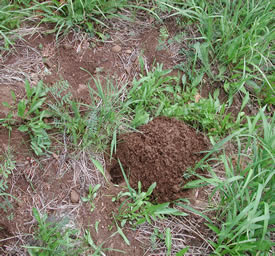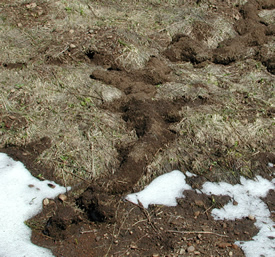This work extends our earlier, chronosequence-based study of mound succession to address effects at larger spatial scales and to assess the role of winter castings (figure, right)—largely ignored in previous studies of gopher disturbance and plant community structure.
We hypothesized that patterns observed at the scale of mounds would extend to larger spatial scales. Specifically,
- greater disturbance would reduce plant cover, graminoid dominance, and species richness, but increase heterogeneity (spatial variation in species composition)
- both mounds and castings would contribute to these effects, but castings less so, due to their smaller size and ephemeral nature
Methods
Sampling.
Four plots (5 x 20 m) were established in three meadows of differing composition. All plots had moderate but variable levels of gopher disturbance. Each plot was sampled with twenty 5 m transects; each transect consisted of 25 contiguous 20 x 20 cm quadrats (see photos, below).
Following snowmelt we estimated cover (%) of mounds (>1 yr old) and castings. Several weeks later, we estimated cover of forb and graminoid species.
Analyses. Mixed-effects models were used to assess the relationships between disturbance (cover of mounds, castings, or their sum) and three measures of community structure:
- Plant cover (total, forbs, graminoids, and forb:graminoid ratio)
- Richness (number of species per transect)
- Heterogeneity (mean Bray-Curtis dissimilarity between pairs of quadrats)
Case,
M. F., C. B. Halpern, and S. A. Levin. 2013. Contributions of gopher mound and casting disturbances to plant
community structure in a Cascade Range meadow complex. Botany 91:555-561. Request reprint |
 |
| Types of gopher disturbance |
| Mounds |
 |
| Gophers form mounds as they dig tunnels and push loose soil to the surface. |
|
| Castings |
 |
| Soil castings form under winter snowpack. Gophers move soil into snow tunnels which are then exposed by spring snowmelt. |
|
|
|
![]()
![]()
![]()
![]()
_Jul 5 2011.jpg)
_13%20Ju%202009_sm.jpg)


_Jun 17 2011_crop_rhomb_500x246.jpg)
_Jul 6 2011_crop_246x246.jpg)